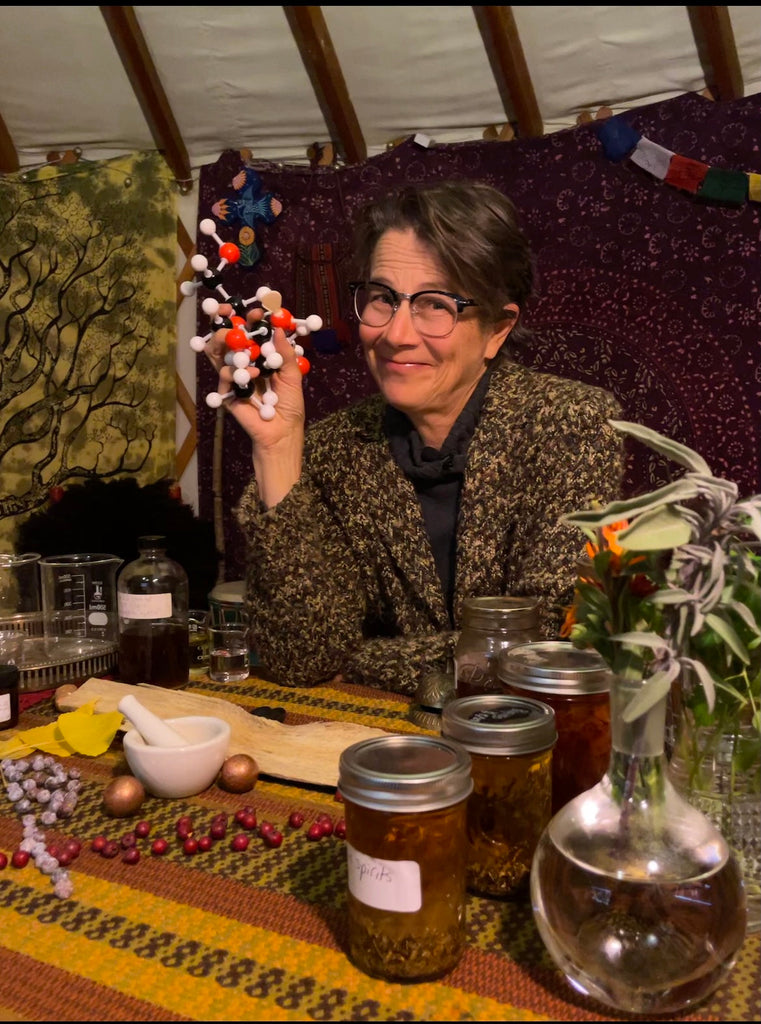Phytochemistry isn't just science- it's the language plants use to connect, communicate and heal.
In a culture that often separates the mystical from the measurable, herbalist, teacher, and author Lisa Ganora invites us to see phytochemistry not as sterile or abstract—but as a living, breathing dialogue between humans and plants. In this episode of The Dancing Willow Podcast, we explored the fascinating and often misunderstood world of herbal constituents—what they are, how they work, and why understanding them is essential to making vibrant, effective medicine.
This blog distills that conversation into a practical guide for anyone curious about the chemistry of herbs and how it relates to vitality, healing, and relationship.
Here is the episode for those who would like to listen- The Magic of Herbal Constituents: Plant Chemistry with Lisa Ganora

Phytochemicals: Energy Patterns in Molecular Form
Phytochemicals are often defined as the active constituents in plants—the compounds that “do the work.” But as Lisa so beautifully explains, they’re much more than that. Phytochemicals are patterns of energy that carry information—biological signals that communicate directly with our bodies.
“When you take an herbal medicine, you’re putting those energy patterns into your system. They’re signals. They encode information.” — Lisa Ganora
Far from being passive ingredients, phytochemicals are created intentionally by plants. Each one represents a kind of intelligence—an energetic intention grounded in molecular form. When we ingest a tea, tincture, or infusion, our bodies receive these signals and respond in complex, layered ways.
This opens a radically different way of thinking about herbal medicine: not as something that acts on us, but as something that we are in relationship with. Just like a conversation, healing is a two-way process.

A Return to Relationship
Modern herbal education often separates intuition from science, but Lisa encourages us to hold both as valid ways of knowing. In fact, one of her first “teachers” was catnip—not through a textbook, but through direct communication.
Skeptical at first, she sat down beside a plant she didn’t know and invited it to speak. What she received were full sentences in her own voice—poetic phrases that, she later discovered, perfectly mirrored the clinical actions of catnip listed in herbal reference books.
“That moment changed my world. Because that wasn’t taught in school.” — Lisa Ganora
This experience reminds us that intuition and observation are foundational to herbalism. The ability to attune to the subtle language of plants—through taste, smell, touch, and presence—is a skill humans have cultivated for millennia.

Organoleptics: Knowing Through the Senses
One of the most accessible ways to understand herbal constituents is through organoleptics, or sensory experience. When we taste a bitter plant, feel the puckering dryness of an astringent, or notice the slippery texture of a demulcent, we are reading the plant’s chemistry with our bodies.
Lisa offers several examples:
Bitters
Bitter-tasting constituents (from alkaloids to sesquiterpene lactones) stimulate digestion, support the liver, relax the nervous system, and activate the parasympathetic “rest and digest” state. Angelica, for instance, is both bitter and aromatic—warming and carminative, like a whole bitters formula in one plant.
Astringents
These tighten and tone tissues—think green tea, raspberry leaf, or oak bark. They can be incredibly healing when used in moderation but overly drying or irritating when overused.
Demulcents
Slippery and soothing, these polysaccharide-rich herbs like marshmallow root, rose hips, and aloe vera help hydrate tissues, cool inflammation, and ease irritation in the gut, throat, or skin.

Plant Chemistry in Practice: Medicine Making & Solubility
Understanding herbal constituents isn’t just academic—it transforms how we make medicine.
Lisa breaks down a common misconception: that a whole plant is either water-soluble or alcohol-soluble. In reality, each plant contains hundreds of constituents, and different groups have different solubility preferences. It’s not about whether a plant is soluble—it’s about which parts of the plant are soluble, in what, and how much.
For example:
- Berberine, a bright yellow alkaloid in Oregon grape root, is highly water-soluble—but some still comes out in alcohol-based tinctures.
- Mushrooms, rich in immune-modulating polysaccharides and triterpenoids, often benefit from dual extraction (hot water + alcohol) to capture their full spectrum of activity.
Understanding solubility means we can intentionally choose whether to make a tea, tincture, infusion, decoction, or oil—and know why we’re choosing it.

Final Thoughts: Listening as Practice
Perhaps the greatest takeaway from this conversation is that plants are always speaking—through taste, scent, chemistry, energy—and our role as herbalists is to listen. Sometimes that means learning about phytosterols and solubility. Sometimes it means sitting quietly with a plant until you hear its message in your own voice.
Both are valid. Both are necessary. And when they come together, herbalism becomes not just a practice, but a partnership.
Here is the episode for those who would like to listen- The Magic of Herbal Constituents: Plant Chemistry with Lisa Ganora
 Learn More from Lisa Ganora
Learn More from Lisa Ganora
Lisa offers in-depth online education for herbalists of all levels, from short foundational courses to a full two-semester deep dive into herbal constituents. Explore her offerings at:
👉 herbalconstituents.com
She also teaches at conferences across the country—so if you get the chance to learn from her in person, don’t miss it.

Stay Connected
Enjoyed this post? Follow our podcast wherever you listen (like spotify or apple podcasts) at "The Dancing Willow", share it with someone who needs it, and support our work by making a purchase with us!
🌿 www.dancingwillowherbs.com
🌿 @dancingwillowherbsco on Instagram

